Marine Corps University Communications Style Guide
CHAPTER THREE: DRAFTING
Drafting refers to the process of putting your ideas on paper in a structured format. By the time you begin drafting, you should have a good sense of the paper’s purpose, audience, and how you will approach your topic. As mentioned in Chapter 2, you should not feel constrained by the planning you did during the invention stage. Your ideas will probably shift and change as you begin drafting. You may even take a completely new perspective on your topic. Likewise, because writing is a recursive process, you may perform some aspects of invention during the drafting phase. For instance, you may map out or outline your supporting paragraphs before you draft them. Similarly, you may find one of your supporting points no longer serves your purpose. In these cases, you may need to revisit some of the products you created during the invention stage and develop new supporting elements. The main sections of this chapter include strategies for approaching the drafting process; general essay structure and the parts of an academic paper; and strategies for writing the introduction, the thesis statement, the body, and the conclusion.
CSG 3.1 Strategies for Approaching the Drafting Process
Listed below are several strategies that may be useful to you as you begin to draft.
1. Accept that the first draft will not be your final draft.
2. Give yourself enough time. While a rapidly approaching deadline does provide some motivation, it does very little to improve the quality of the writing produced. Writing is a process; it takes time and involves multiple steps. Giving yourself the time to put your draft aside for a day or two before revising will help you spot mechanical or logical problems in your writing. In addition, the earlier you complete your draft, the more time you will have to seek a peer or faculty review.
3. Remember to be flexible in your writing. If you begin to formulate new ideas as you are drafting, do not be afraid to refine your original ideas.
4. Consult your outline as you draft to make sure you are staying on topic. At the same time, do not become so fixated on your outline that you are unable to make changes if your ideas on your topic shift.
Do not edit your paper as you draft. Instead, focus on writing your ideas. You can reevaluate logic, structure, grammar, and word choice once you have a complete first draft. It is often helpful to step away from your completed draft for a short period of time and come back with fresh eyes to revise. For more information on the revision process, see chapter 4.
CSG 3.2 General Essay Structure: Parts of an Academic Paper
Most papers contain three main parts: the introduction, the body, and the conclusion. The introduction gives the reader a sense of what the paper will be about and the issue it will examine. It presents the reader with the thesis and sets the stage for the rest of the paper. The body provides evidence and ideas to support the thesis. Finally, the conclusion revisits the paper’s main ideas and closes the argument. In addition to the introduction, body, and conclusion, a research-based paper might include front matter such as a table of contents, preface, and acknowledgements; it might also contain back matter such as appendices, endnotes, and a bibliography. The length, focus, and nature of these parts of the paper will vary depending on the type of writing task you have undertaken. For instance, in longer papers, the body may contain several paragraphs covering separate topics related to the thesis; shorter papers, on the other hand, may include only one paragraph to discuss each supporting point.
CSG 3.3 Writing the Introduction
The introduction varies in length and complexity, depending on the type and length of the paper you are writing. For instance, if you are writing a five-page paper, your introduction may be only a short paragraph. If you are writing a fifty-page paper, however, your introduction may be several paragraphs long. Generally, the introduction contains enough background information to lead up to your thesis statement. The thesis statement is usually the last sentence (or group of sentences) in your introduction, but you should place the thesis statement where it will be most effective for the purposes of your paper and for the reader’s needs. An effective introduction should accomplish the following tasks:
1. Capture the reader’s interest.
2. Present sufficient context for the reader to understand your argument.
3. Establish your purpose for writing.
4. Present a thesis statement that you will support in the body of the paper.
Capturing the reader’s interest: you might present a controversial claim, a lesser-known fact, or a vignette to gain the reader’s interest.
Presenting context: the introduction should present the problem or phenomenon you will discuss in the paper and provide relevant background information about the topic or issue.
Establishing purpose: the introduction should tell the reader why your topic is significant and why the reader should care about your topic.
Presenting a thesis statement: by the end of the introduction, the reader should have an understanding of what the paper will argue and why this argument is valuable. Almost all academic writing should present some type of arguable thesis statement.
While you may draft an introduction before writing the body of the paper, your ideas will frequently begin to shift and evolve as you complete your research. Just as you may need to adjust your thesis statement throughout the research and writing process, you may need to adapt the introduction to the new ideas you introduce later in the paper. Since it is often difficult to know exactly what shape the paper will take before you sit down to write, you may want to begin the drafting process by developing a strong thesis statement and supporting body paragraphs. When you finish writing the body of the paper, you can return to the introduction. It is important for the introduction to tell the reader exactly what the paper will do and how it will treat your topic. Therefore, even if you have crafted what you think is a strong introduction before developing the body paragraphs, that introduction may no longer suit the paper upon completion. Figure 12 presents an example of an introduction written by a student during the 2015–16 academic year for the assignment prompt displayed in figure 11.
Figure 11. Assignment prompt for innovation essay
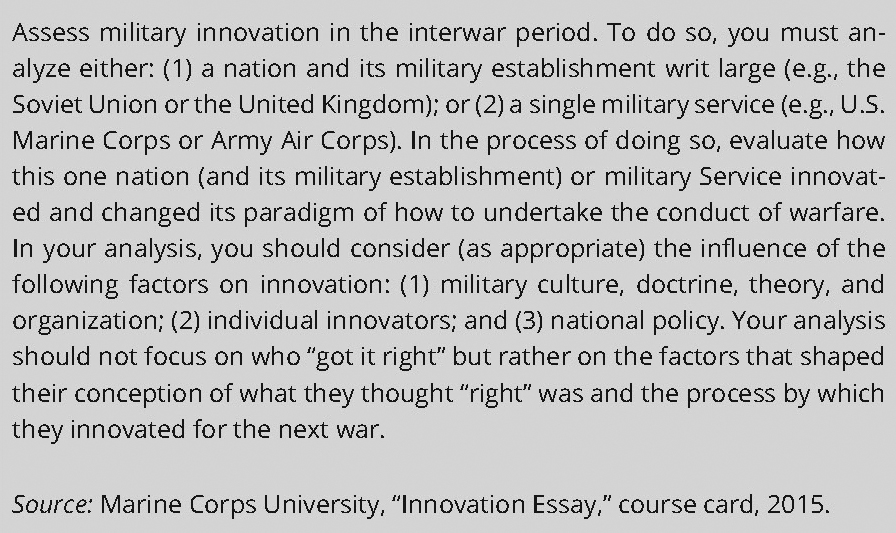
Figure 12. Sample student introductory paragraph for innovation essay
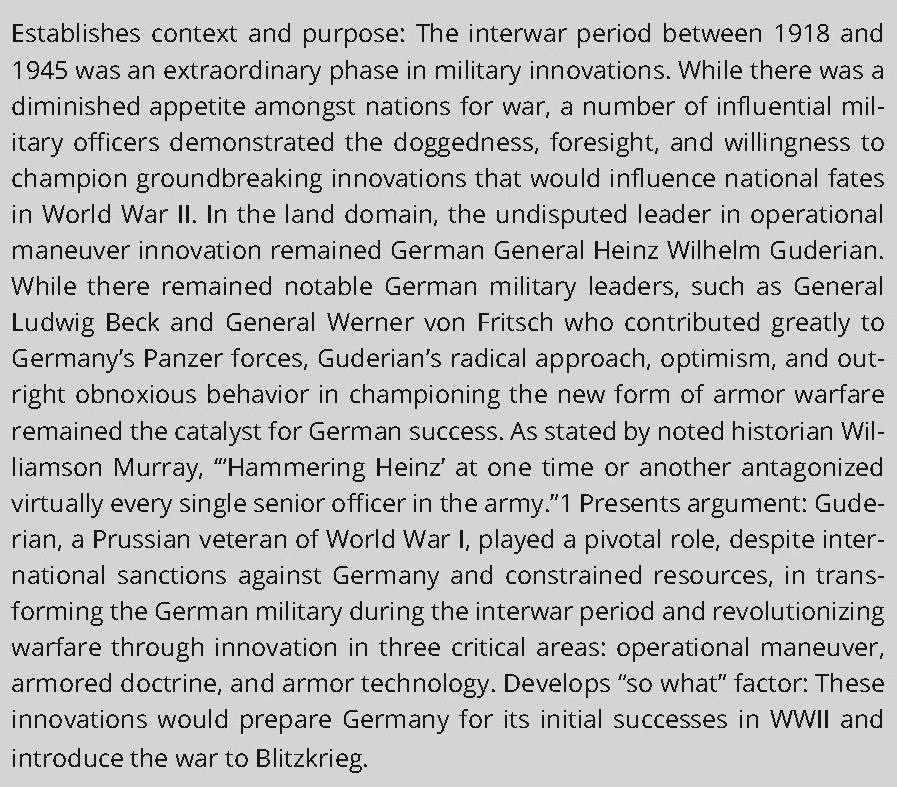
Figure 13. Sample student introduction showcasing pitfalls
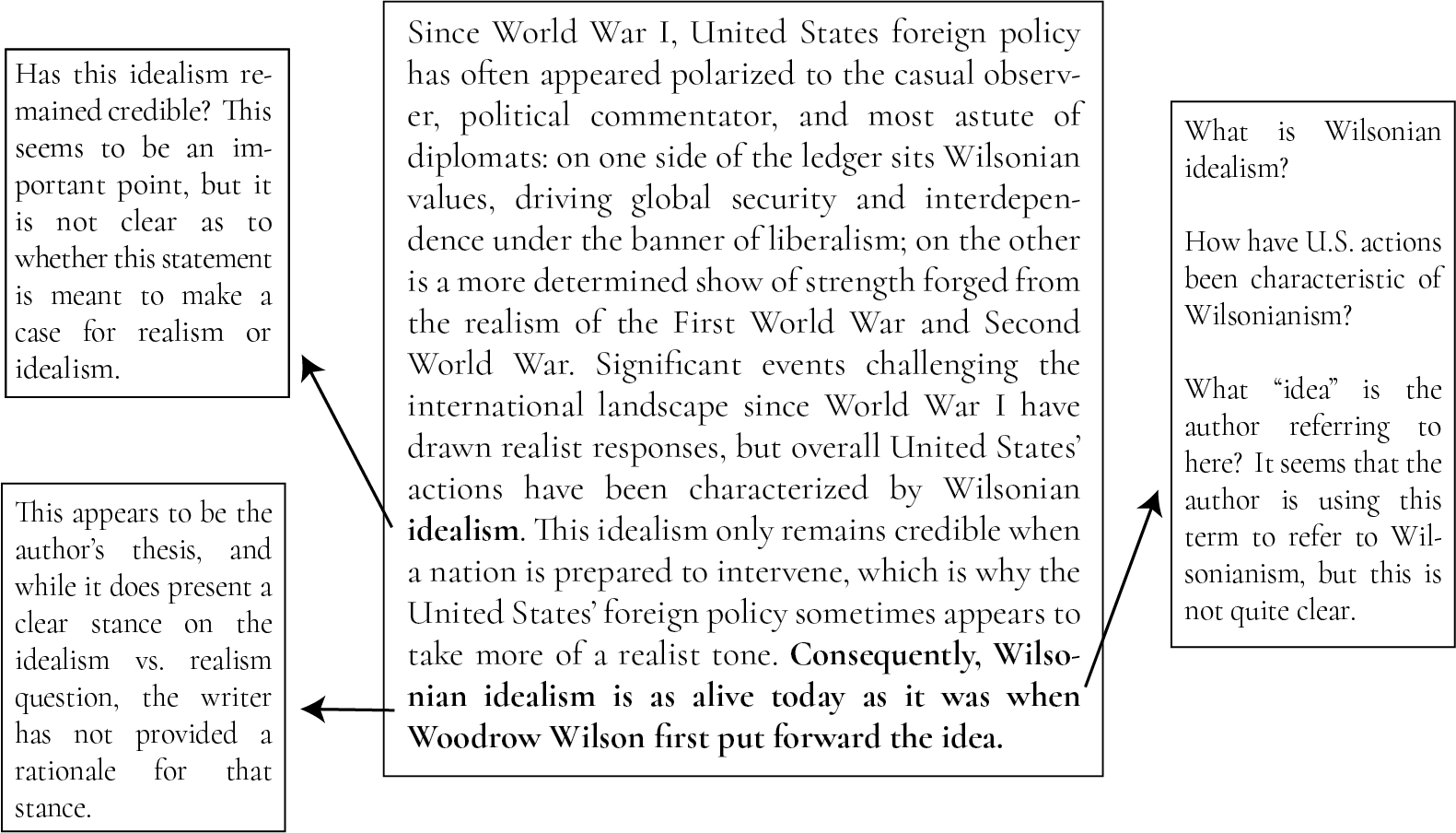
Below are common pitfalls to avoid when drafting your introduction:
Vague terms: vague terms include undefined acronyms, abstract ideas and concepts, and subjective expressions.
Broad, sweeping statements: these types of statements include trite, overused expressions and overgeneralizations, such as “from the beginning of time.”
Including information that is too specific: if you want to investigate how George Washington shaped the Continental Army, you do not need to provide examples of his leadership style in the introduction. Save these specific details for the body of the paper.
Creation of suspense: the readers should not have to “dig” or read beyond the introduction to get a sense of what the paper is about. Figure 13 is an example of an introduction that demonstrates some of these pitfalls.
Although the student makes a clear statement regarding the continued dominance of Wilsonian idealism in American foreign policy, it is not clear as to what makes this claim relevant or how it supports the author’s thesis. In figure 14, you will find a more fully developed version of this introduction.
Figure 14. Effective sample student introduction
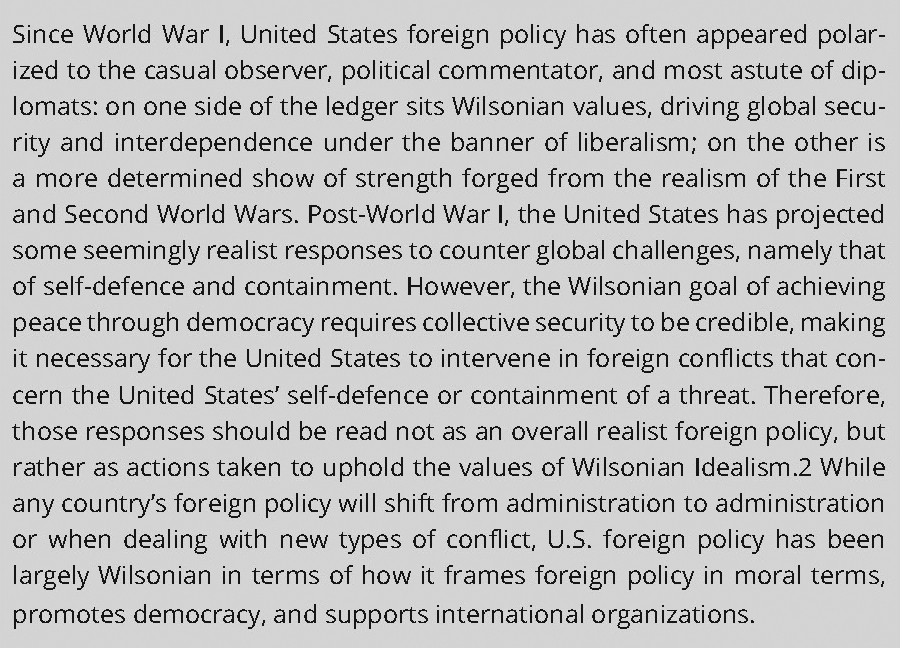
This introduction is effective because it not only provides contextual information about the topic but also defines terms clearly so readers can follow the discussion. The argument occurs at the end of the introduction and answers the questions what, why, and how. Successful introductions provide readers with a clear sense of direction, allowing them to understand what the main argument is, how it will be supported with evidence in the body of the paper, and why it is important.
CSG 3.4 Writing the Thesis Statement
Most academic papers contain a thesis statement at the end of the introduction that expresses the writer’s specific position on the topic. The thesis statement may be thought of as the main “controlling idea” in the paper. The supporting paragraphs and sentences within those paragraphs should relate to and support the thesis in some way.
Your purpose for writing as well as the audience you are writing for will influence the thesis statement. For instance, a thesis statement for a compare and contrast paper may be slightly different than a thesis used in an arguable research paper. See chapter 2 for more information about common academic writing assignments you may complete at Marine Corps University. Below are a few characteristics of effective thesis statements.
The thesis should take a stand. The word “thesis” comes from the Greek word meaning “position.” Therefore, the thesis statement should do more than simply state your topic; it should express your stance on that topic. That is, it must present a position you can argue. Consider the following thesis statement:
Weak thesis: This paper evaluates the Army’s reaction to nuclear-focused defense policies that emerged after World War II.
Questions readers may have include: What was the Army’s reaction to these nuclear-focused defense policies? What is the main argument the author will make regarding these policies? Is the author making a claim about the efficacy of these policies?
Revised thesis: Despite nuclear-focused defense policies and theories that marginalized the Army immediately following World War II, the Army displayed resiliency and flexibility by leveraging doctrine, reorganization, and technology to remain relevant during the atomic age.
This thesis acknowledges the specific attributes that allowed the Army to meet the challenges these nuclear-focused defense policies introduced. Additionally, it presents this argument without explicitly stating what the paper will do, even though the thesis clearly articulates the author’s intent.
The thesis should give the reader a sense of how the argument will be supported. The thesis frequently presents the criteria that the writer will address in the body of the paper. For instance, if you were to write, “The curriculum at the Command and Staff College requires students to develop strong critical thinking, critical reading, and writing skills,” the reader would expect the body of the paper to address how the curriculum encourages the development of critical thinking, critical reading, and writing skills. If you decided to include a paragraph about research skills, you might confuse your reader.
As such, you may want to think of the thesis statement as providing a roadmap for your paper. It expresses your position on a topic and often introduces the main supporting points you will use to support your argument.
The thesis should answer the questions what, how, and why. What is your argument? How will you develop the argument in the body of the paper? Why is the argument important? The thesis example below needs to be revised to show how the argument will be developed.
Weak thesis: The Army must improve its training to better prepare its company grade officers to fight full-spectrum conflicts.
This sentence gives the writer a starting point and additionally gives a reason for this change. However, it does not tell the reader specifically how the Army should improve its training. An improved, polished thesis statement might read as follows:
Revised thesis: The Army must leverage civilian graduate education programs, as opposed to traditional training methods, to better prepare its combat arms company grade officers for stability operations.
The thesis should contain clear language and avoid abstract terminology. The thesis should contain a clearly defined argument. Below is an example of an unclear thesis.
Unclear thesis: Prohibiting military personnel from attending political protests is unethical and goes against principles of democracy.
The term unethical is rather subjective here. Specifically, readers may ask themselves, “What about preventing military personnel from attending political protests is unethical? How does it go against principles of democracy?” A more clearly worded thesis statement appears below.
Revised thesis: Prohibiting military personnel from attending political protests is dangerous to the future of the armed forces and to the United States in general because it violates an individual’s right to free speech and prevents opposing viewpoints from being heard.
This thesis statement takes a position and makes a claim that can be argued. It explains what is dangerous (e.g., prohibiting military personnel from attending political protests). Additionally, it explains why this is dangerous (e.g., it violates an individual’s right to free speech and prohibits opposing viewpoints from being heard).
CSG 3.4.1 Writing Thesis Statements that Answer Assignment Questions
The process for developing a thesis statement might be slightly different when you are required to respond to a specific writing prompt. In this case, the thesis statement should specifically address the key components of the assignment question. See chapter 2 for more information about identifying key words and analyzing assignments. Table 4 presents an example of how you might develop a working thesis statement to answer an assignment question.
Table 4. How to develop a working thesis statement
|
Assignment question
|
How did the British military’s counterinsurgency strategy in Malaya differ from the French military’s counterinsurgency strategy?
|
|
Student thesis
statement
|
The counterinsurgency method the British used in Malaya was more successful than the counterinsurgency strategy employed by the French.
|
|
Critique of thesis statement
|
This statement provides a starting point, but it still needs to be further refined. Although the author tells how the insurgency was different (i.e., more successful), the author needs to explain why this is the case.
|
|
Final thesis
statement
|
The British method of counterinsurgency in Malaya was ultimately more successful than the French strategy because the British focused on reinforcing the perception of legitimacy, whereas the French resorted to unrestrained military action.
|
The process of developing a thesis statement is different when writing a research paper than it is when writing a paper that answers a specific prompt or question. The thesis in a research paper will often begin as a research question that helps to guide the focus of the research. After all, it is difficult to know exactly what your main point will be until you have considered other sources on your topic. Because your ideas about your topic may shift as you continue to research, the thesis you present in your final draft may not reflect your initial stance on the issue. You can find more information about developing research questions and a working thesis statement for research papers in Part Two: Research and Documentation.
CSG 3.5 Writing the Body
The body comprises the fundamental components of the paper and provides specific evidence to support the paper’s thesis statement or central argument. As discussed in the previous section, the thesis statement takes a position on the issue you will write about and often presents the main supporting points you will use to argue that position. Once you have written your concrete thesis statement, it is easier to draft and organize the body from those main supporting points. Consider the following sample thesis statement that was provided earlier in the chapter.
Prohibiting military personnel from attending political protests is dangerous to the future of the armed forces and to the United States in general because it violates an individual’s right to free speech and prevents opposing viewpoints from being heard.
From reading this thesis statement, we can assume the author’s central argument is that barring military service members from going to these types of events is “dangerous to the future of the armed forces and to the United States in general” and that the author will support this argument by showing how prohibiting military personnel from attending political protests violates free speech and prevents opposing viewpoints from being heard. If you were to outline a paper on this topic, it might look like the outline in figure 15.
Figure 15. Sample outline developing paper topic

Another way of conceptualizing a thesis and supporting points is by making a topic sentence outline in which the topic sentence supports one component of the thesis statement. Figure 16 presents an example of how you might use a mind map to diagram your thesis and supporting points.
Figure 16. Mind map of thesis and supporting points

These main supporting points might then form the topic sentences for the paper’s supporting paragraphs. Figure 17 is an example of a topic sentence outline.
Figure 17. Example topic sentence outline
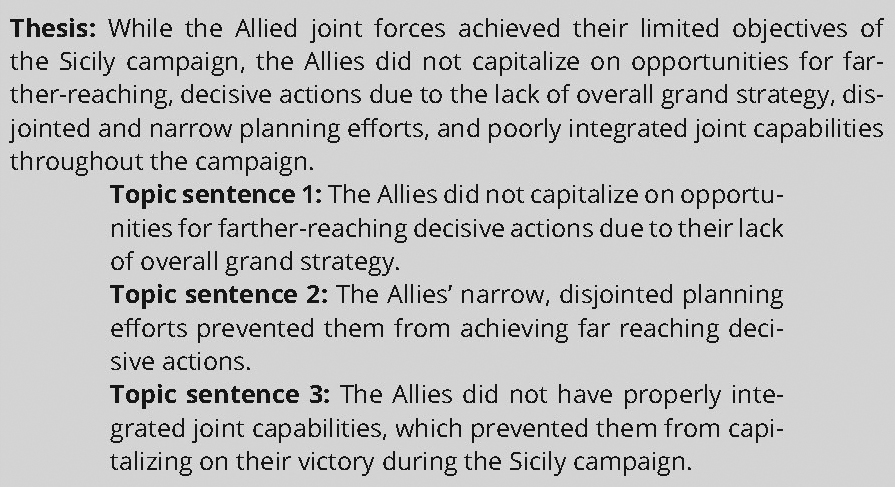
The number of examples you use depends on the length and scope of the assignment. When given the choice, strive to develop a few examples fully rather than providing only a broad overview of many examples.
CSG 3.5.1 Body Paragraphs
Paragraphs are units of information. Writers use paragraphs to help their readers process ideas as related chunks of information.
The internal organization of a body paragraph is quite similar to the organization of an essay or argument paper. Like the paper itself, individual paragraphs often move from general to specific information. Many writers find the MEAL plan to be a helpful model of paragraph development. The MEAL plan consists of four main elements: main idea (M), evidence (E), analysis (A), and link (L). These four elements are described in more detail below.
1. Main idea: presents the central claim the paragraph will address (think of this as the thesis of the paragraph). The first sentence of the paragraph often expresses the main idea and is frequently referred to as the topic sentence. The topic sentence sometimes includes a transition back to the ideas presented in the previous paragraph.
2. Evidence: these sentences present specific examples and arguments to demonstrate support for the claim presented in the main idea or topic sentence. Sentences that provide evidence are also referred to as supporting sentences.
3. Analysis: these sentences explain how the supporting evidence applies to the topic of the paragraph; they “digest” the information for the reader. Sentences that provide analysis are another type of supporting sentence.
Note: there may be times when it is difficult to distinguish evidence sentences from analysis sentences. If you find this is the case with your writing, do not panic. It is not essential to differentiate between these types of sentences as long as each body paragraph contains both evidence and analysis.
4. Link: also known as a transition, this sentence reinforces the paragraphs main idea, explains it significance, and /or connects the main idea to the next body paragraph. See section 3.5.2 for more information about transitions.
A paragraph will often begin with a topic sentence that provides the reader with a sense of the main idea or point the paragraph will cover. The supporting sentences then provide evidence to substantiate that topic sentence and analysis that connects tells the reader why each piece of evidence is relevant and how it supports the paragraph’s main idea. These types of sentences are especially important in persuasive writing because they help to explain the rationale behind the claims the paragraph makes. Once the paragraph presents the supporting evidence and the analysis of that evidence, it may conclude with a linking sentence that helps to sum up the paragraph’s central theme and connects it back to the paper’s main argument.
In accordance with the paragraphing principles above, a body paragraph template might look like the example below.
Main idea (introduces paragraph’s central argument/connects to thesis). Evidence (provides specific examples and support for paragraph’s main idea) xxxxxxxxxxxxxxx xxxxxxxxxxxxxxxxxxxxxxxxxx xxxxxxxxxxxxxxxxxxxxxxxxxxxxxxxxxxx xxxxxxxxxxxxxxxxxxxxxxxxxxxxxx xxxxxxxxxxxxxxxxxxxxxxxxxxxxxxxxxx. Analysis (explains how the evidence supports the paragraph’s main idea; makes connections for the reader) Link (sums up paragraph’s main idea and transitions to the next point).
A redacted body paragraph that follows this paragraph may look something like this:
[Topic sentence] The problem with implementing a military solution in Syria is …. [Evidence #1] Theorist Y furthers this point in his article “name of article” in which he states…. [Evidence #2] General Z has also observed these issues on the ground in Syria, reporting that…. [Analysis] General Z’s reports demonstrate Theorist Y’s claims by …. [Link/conclusion] Therefore, the U.S. response to the Syrian Civil War must consider…
Figures 18 and 19 offer two examples of how these main components of a paragraph (topic sentence, supporting points, and clincher sentences/transitions) look in fully developed paragraphs.
Figure 18. Sample fully developed paragraph on Wilsonian idealism

Figure 19. Sample fully developed paragraph on the Civil War
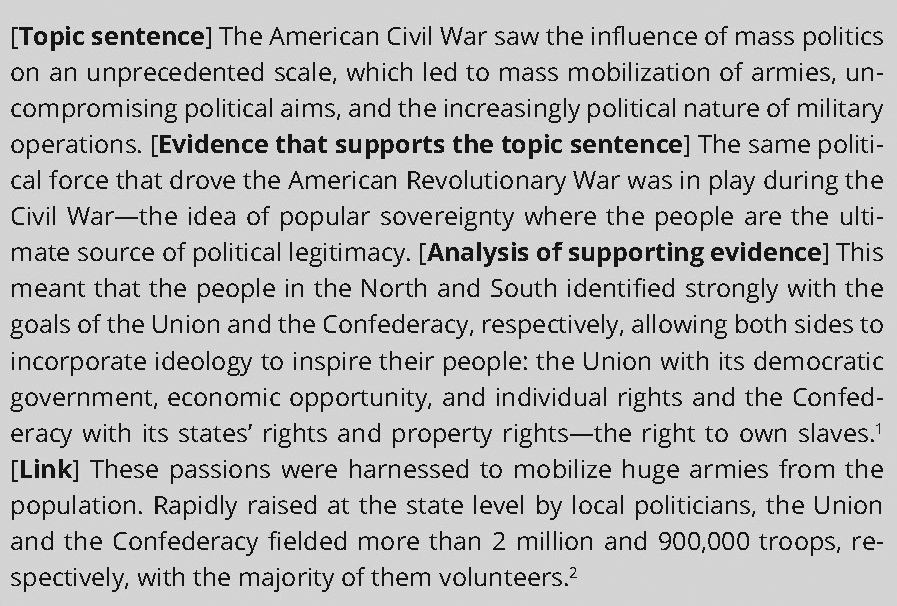
CSG 3.5.2 Transitions
The use of transitions is paramount to good organization. Transitional words and phrases connect sentences, ideas, and paragraphs to one another in order to indicate to readers how an idea will develop. We use transitions in written and spoken communication. It is important that the transitional words or phrases you use in your writing serve your intended purpose. Table 5 shows a list of common transitional words and phrases you can use in your writing and speaking projects.
Table 5. Transition examples
|
To show cause and effect
|
therefore, so, thus, hence, as a result, consequently, accordingly, since, then
|
|
To compare
|
likewise, similarly, in the same way, in comparison, compared to, along the same lines
|
|
To contrast
|
however, in/by contrast, conversely, although, on the contrary, on the other hand (preceded by on one hand), yet, nevertheless, nonetheless, regardless, whereas, while, despite, even though, but
|
|
To add to an
argument
|
in addition, furthermore, moreover, further, also, so too, in fact, besides, and, indeed
|
|
To give an
example
|
for example, for instance, specifically, consider, to take a case in point, after all, as demonstrated by
|
|
To provide a
counterargument
|
admittedly, although, granted, one can concede that, to be sure, yet, of course
|
|
To conclude
|
in conclusion, consequently, in summary, as a result, hence, therefore, thus
Note: these are similar to those used to show cause and effect.
|
Source: adapted from Gerald Graff and Cathy Birkenstein, They Say I Say: The Moves that Matter in Persuasive Writing, 4th ed. (New York: W. W. Norton, 2018), 321–22.
Transitions are also used to integrate quoted, summarized, or paraphrased material in the text of a paper. These transitions are called “signal phrases.” It is important to use transitions to signal to readers that the idea you are presenting comes from an outside source and not from you, the author—as failing to indicate this may be considered plagiarism. For more information on quoting, summarizing, and paraphrasing, see chapter 8. Below is a list of common transitional words and phrases that can be used as signal phrases.
Common signal phrases
• Smith argues . . .
• According to Smith . . .
• Smith contends . . .
• Smith describes . . .
• In Smith’s view . . .
• From Smith’s perspective . . .
Failing to use transitions may result in disjointed writing—abrupt endings or jumps between sentences or paragraphs.
The paragraph below is difficult to follow at times because the connections between ideas expressed in individual sentences are not clear. It is not always immediately apparent as to how one idea progresses to the next.
Political and social transformation in mid-nineteenth century Prussia was largely favorable to Moltke’s quest for reform. Moltke’s relationship with his political masters was at times turbulent. In 1866, King William I of Prussia authorized Moltke to issue orders direct to operational commands. Moltke increased his influence in military affairs, after which King William appointed him the field commander of Prussian armies. Improving upon earlier efforts to restructure its force in response to the French levee en masse, in 1859, Prussia further transformed its force from despotism to a national army that centered on universal conscription. The transformation would have far-reaching consequences, fundamentally altering the balance of power in Europe. By the time the reforms were complete, Prussia had defeated both France and Austria in open war, unified Germany under Prussian hegemony, and changed the way western militaries plan for and conduct warfare.
Below is a revised version of the previous paragraph—this time with effective transitions that clearly demonstrate the relationships between ideas in the paragraph.
Political and social transformation in mid-nineteenth century Prussia was largely favorable to Moltke’s quest for reform. Moltke’s relationship with his political masters was at times turbulent, but in 1866, King William I of Prussia authorized Moltke to issue orders directly to operational commands, thereby increasing his influence in military affairs and effectively appointing him the field commander of Prussian armies. Improving upon earlier efforts to restructure its force in response to the French levee en masse, Prussia further transformed its force from despotism to a national army that centered on universal conscription. This latest restructuring, coupled with Moltke’s increased influence over the military, fundamentally altered the balance of power in Europe. By the time Moltke’s reforms were complete, Prussia had defeated both France and Austria in open war, unified Germany under Prussian hegemony, and changed the way western militaries plan for and conduct warfare.
Transitions are used not only to highlight relationships between ideas within paragraphs but also to show relationships between paragraphs and sections of a text. The text below highlights disjointedness between two paragraphs in a student paper about modern military theorists.
Che Guevara had a much more global view in spreading Marxism than Mao did. Mao wanted to unite China under communist rule, while Che wanted to spread his ideology across the globe. Both men knew that leading the peasant class was the way to generate their power, but Che was much more focused on the use of violent guerrilla tactics to overthrow governments.
While Mao used a multipronged approach with his choices of tactics, Che believed that high-profile attacks, with support of the masses, would spark large-scale revolution regardless of circumstance.
David Galula, a French officer, formed his opinions on insurgency and counterinsurgency from fighting in the Algerian War. . . .
In this example, the author jumps from a comparison of Mao Zedong and Che Guevara to an idea about David Galula, a counterinsurgency theorist, without a clear transition. In the same way that an artist would take yellow paint and blue paint to make green paint, a writer can transition between paragraphs using a sentence or phrase that connects the two different ideas. The blue section uses a clear transition to connect the main ideas from the two paragraphs and to signal a contrast.
Mao pursued political organization of the peasants with the goal of enhancing military power. Mao successfully achieved his goal, and when the nationalists fled to the island of Taiwan in 1949, he declared the People’s Republic of China.
While Mao achieved his aim and carried out a successful War of Revolution (Jiefang), Ernesto “Che” Guevara was less successful as he was executed after being captured by Bolivian forces in 1967 in his quest to export the revolutionary thoughts.
CSG 3.5.3 Introducing Counterarguments
In addition to including supporting examples, academic research papers can also address counterarguments. A counterargument presents an opposing view to your thesis or some part of it; counterarguments challenge the primary argument you present in the paper.
Why Address a Counterargument? Addressing a counterargument allows you to strengthen your argument by demonstrating an understanding of opposing viewpoints and systematically debunking opposing claims. The checklist below presents strategies for analyzing arguments that opponents might use to counter your claims. By analyzing your opponent’s argument and understanding how the argument is structured, you will be more equipped to respond to the argument.
Analyzing your opponent’s argument
- Are there facts that your opponent has not considered?
- Is your opponent basing their conclusions on different premises (supporting pieces of evidence)?
- Has your opponent presented faulty or incorrect information?
- Does the problem stem from a difference in understanding of terms?
- Are you drawing different conclusions from the same premises (the same pieces of evidence)?
- Is your opponent’s point of view a result of competing political, economic, or social interests?
Once you have analyzed the counterargument, you will need to develop a plan for addressing that argument in a way that strengthens your paper’s central claim. This might mean highlighting a flaw in the counterargument or demonstrating that the validity of the argument is limited (i.e., it may apply only in certain circumstances).
Addressing counterarguments effectively: do not contradict your main point
For counterarguments to be effective, they need to be addressed carefully.
- First, it needs to be clear to the reader that you are addressing an opposing point of view.
- After explaining the opposing point of view, you will need to either refute or accommodate that point of view. In other words, you need to show your initial stance is still valid despite these opposing views.
- When you refute a counterargument, you use evidence to argue the point is incorrect or misunderstood. When you accommodate a counterargument, you might acknowledge its legitimacy, but you may argue it is unimportant or irrelevant to the issue at hand.
Typically, a counterargument response will include three main parts: 1) a restatement or summary of an opposing point of view, 2) a response to the opponent’s point of view (which typically addresses what you see as pitfalls in your opponent’s argument), and 3) evidence that supports your response to the counterargument. Figure 20 demonstrates how an author might incorporate a counterargument to bolster his or her central claim.
Figure 20. Incorporating and addressing counterarguments

The example above effectively incorporates and addresses a counterargument: the first paragraph establishes a common criticism of DePuy’s work (the counterargument). It then acknowledges that while some of this criticism is valid, Operations (FM 100-5) established an effective framework for planning current Army operations (that is, it shows the overall worth of the document while acknowledging its limitations).
Where should I place my counterargument? Where you decide to place a counterargument may depend on your purpose and how likely your reader is to disagree with your thesis. Some common placements of counterarguments are as follows:
1. The counterargument may be part of the introduction, allowing you to place your thesis statement in contrast to the counterpoint.
2. The counterargument may be placed after the introduction but before the first supporting paragraph. This gives you the chance to acknowledge opposing points of view and to anticipate and debunk your opponents’ objections before presenting your own argument. Beginning with a counterargument can be particularly useful when writing for an audience that might be hostile towards your point of view.
3. The counterargument may appear in the body of the paper. In this case, you might briefly address an opposing point of view before returning to your central argument.
4. The counterargument may appear before the conclusion, allowing you to acknowledge opposing viewpoints before moving into your concluding paragraph. This works well with a reader who is sympathetic to your point of view.
CSG 3.6 Writing the Conclusion
After reading the introduction and body of your paper, a reader should fully understand your argument and its supporting components. The conclusion then revisits that argument from an enlightened point of view—the view of a reader who is now familiar with your claims. The conclusion should make connections between the main points the paper presents and draw broader implications. It may include a call to action or present an issue that is worthy of further study. The conclusion serves the following purposes:
1. Provides the “so what” factor or discusses implications
2. Gives the reader a sense of closure
3. Synthesizes material you have presented in the body of the paper
Below is a list of pitfalls to avoid when writing the conclusion.
1. Rewriting the introduction in different words: the introduction and conclusion should not contain the same information. While the introduction presents the information you will discuss in the body, the conclusion is your “last word” on the topic. Once readers reach the conclusion, they are already familiar with your argument. Therefore, restating the information you present in the introduction may insult the reader’s intelligence or leave the reader asking, “So what?” Instead, focus the conclusion on the broader implications of your thesis and findings.
2. Restating the thesis statement verbatim: while you will want to revisit the paper’s central argument (thesis), you likely will want to put this argument in different words. Direct repetition, although it can be a valuable component in oral communication, is not necessarily as effective in an academic paper.
3. Introducing new information: the conclusion should not present new or additional evidence or ideas to support your thesis. While you may want to introduce some issues for consideration or topics/questions for further study, you do not want to present new or unfamiliar information in the conclusion. Figure 21 presents a sample introduction and conclusion. Figures 21 and 22 demonstrate two sample introductions and conclusions.
Figure 21. Sample introduction and conclusion: “Preventing Chaos: Conditionality of Nuclear Proliferation”

Figure 22. Sample introduction and conclusion: “Wilsonian Idealism: An American Tradition”

The concluding paragraph in figure 21 is effective because it revisits some of the main themes discussed in the paper without directly restating the thesis statement. It broadens the discussion of nuclear weapons (“these elements not only restrain . . .”) without introducing new information. Figure 22 showcases another example introduction and conclusion.
The concluding paragraph in figure 22 reiterates the paper’s main idea (“Wilsonian idealism has endured as the prominent influence . . .”) and briefly discusses how Wilsonian idealism might look in the future.
This chapter addressed the main components of an academic essay. However, it is important to remember that writing is a multiple-step process—it is unlikely your first draft will be your final draft. Most successful writing involves not only invention and drafting but also a rigorous revision process. Chapter 4 provides strategies for revising your draft to make it a polished final product.